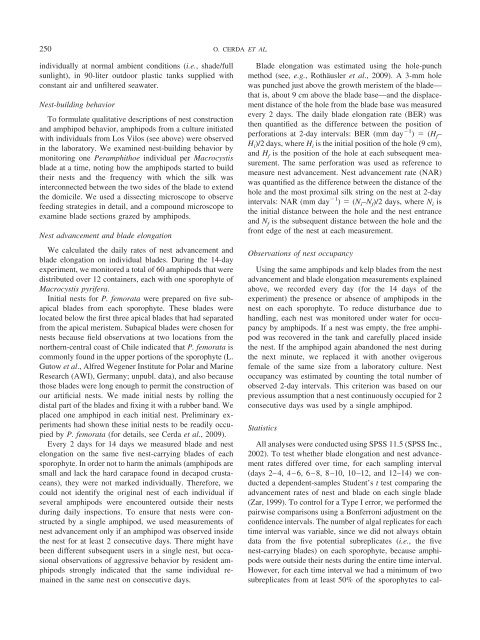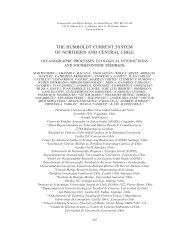Nest-Building Behavior by the Amphipod Peramphithoe ... - Bedim
Nest-Building Behavior by the Amphipod Peramphithoe ... - Bedim
Nest-Building Behavior by the Amphipod Peramphithoe ... - Bedim
You also want an ePaper? Increase the reach of your titles
YUMPU automatically turns print PDFs into web optimized ePapers that Google loves.
250 O. CERDA ET AL.<br />
individually at normal ambient conditions (i.e., shade/full<br />
sunlight), in 90-liter outdoor plastic tanks supplied with<br />
constant air and unfiltered seawater.<br />
<strong>Nest</strong>-building behavior<br />
To formulate qualitative descriptions of nest construction<br />
and amphipod behavior, amphipods from a culture initiated<br />
with individuals from Los Vilos (see above) were observed<br />
in <strong>the</strong> laboratory. We examined nest-building behavior <strong>by</strong><br />
monitoring one <strong>Peramphithoe</strong> individual per Macrocystis<br />
blade at a time, noting how <strong>the</strong> amphipods started to build<br />
<strong>the</strong>ir nests and <strong>the</strong> frequency with which <strong>the</strong> silk was<br />
interconnected between <strong>the</strong> two sides of <strong>the</strong> blade to extend<br />
<strong>the</strong> domicile. We used a dissecting microscope to observe<br />
feeding strategies in detail, and a compound microscope to<br />
examine blade sections grazed <strong>by</strong> amphipods.<br />
<strong>Nest</strong> advancement and blade elongation<br />
We calculated <strong>the</strong> daily rates of nest advancement and<br />
blade elongation on individual blades. During <strong>the</strong> 14-day<br />
experiment, we monitored a total of 60 amphipods that were<br />
distributed over 12 containers, each with one sporophyte of<br />
Macrocystis pyrifera.<br />
Initial nests for P. femorata were prepared on five subapical<br />
blades from each sporophyte. These blades were<br />
located below <strong>the</strong> first three apical blades that had separated<br />
from <strong>the</strong> apical meristem. Subapical blades were chosen for<br />
nests because field observations at two locations from <strong>the</strong><br />
nor<strong>the</strong>rn-central coast of Chile indicated that P. femorata is<br />
commonly found in <strong>the</strong> upper portions of <strong>the</strong> sporophyte (L.<br />
Gutow et al., Alfred Wegener Institute for Polar and Marine<br />
Research (AWI), Germany; unpubl. data), and also because<br />
those blades were long enough to permit <strong>the</strong> construction of<br />
our artificial nests. We made initial nests <strong>by</strong> rolling <strong>the</strong><br />
distal part of <strong>the</strong> blades and fixing it with a rubber band. We<br />
placed one amphipod in each initial nest. Preliminary experiments<br />
had shown <strong>the</strong>se initial nests to be readily occupied<br />
<strong>by</strong> P. femorata (for details, see Cerda et al., 2009).<br />
Every 2 days for 14 days we measured blade and nest<br />
elongation on <strong>the</strong> same five nest-carrying blades of each<br />
sporophyte. In order not to harm <strong>the</strong> animals (amphipods are<br />
small and lack <strong>the</strong> hard carapace found in decapod crustaceans),<br />
<strong>the</strong>y were not marked individually. Therefore, we<br />
could not identify <strong>the</strong> original nest of each individual if<br />
several amphipods were encountered outside <strong>the</strong>ir nests<br />
during daily inspections. To ensure that nests were constructed<br />
<strong>by</strong> a single amphipod, we used measurements of<br />
nest advancement only if an amphipod was observed inside<br />
<strong>the</strong> nest for at least 2 consecutive days. There might have<br />
been different subsequent users in a single nest, but occasional<br />
observations of aggressive behavior <strong>by</strong> resident amphipods<br />
strongly indicated that <strong>the</strong> same individual remained<br />
in <strong>the</strong> same nest on consecutive days.<br />
Blade elongation was estimated using <strong>the</strong> hole-punch<br />
method (see, e.g., Rothäusler et al., 2009). A 3-mm hole<br />
was punched just above <strong>the</strong> growth meristem of <strong>the</strong> blade—<br />
that is, about 9 cm above <strong>the</strong> blade base—and <strong>the</strong> displacement<br />
distance of <strong>the</strong> hole from <strong>the</strong> blade base was measured<br />
every 2 days. The daily blade elongation rate (BER) was<br />
<strong>the</strong>n quantified as <strong>the</strong> difference between <strong>the</strong> position of<br />
perforations at 2-day intervals: BER (mm day 1 ) (H f –<br />
H i )/2 days, where H i is <strong>the</strong> initial position of <strong>the</strong> hole (9 cm),<br />
and H f is <strong>the</strong> position of <strong>the</strong> hole at each subsequent measurement.<br />
The same perforation was used as reference to<br />
measure nest advancement. <strong>Nest</strong> advancement rate (NAR)<br />
was quantified as <strong>the</strong> difference between <strong>the</strong> distance of <strong>the</strong><br />
hole and <strong>the</strong> most proximal silk string on <strong>the</strong> nest at 2-day<br />
intervals: NAR (mm day 1 ) (N i –N f )/2 days, where N i is<br />
<strong>the</strong> initial distance between <strong>the</strong> hole and <strong>the</strong> nest entrance<br />
and N f is <strong>the</strong> subsequent distance between <strong>the</strong> hole and <strong>the</strong><br />
front edge of <strong>the</strong> nest at each measurement.<br />
Observations of nest occupancy<br />
Using <strong>the</strong> same amphipods and kelp blades from <strong>the</strong> nest<br />
advancement and blade elongation measurements explained<br />
above, we recorded every day (for <strong>the</strong> 14 days of <strong>the</strong><br />
experiment) <strong>the</strong> presence or absence of amphipods in <strong>the</strong><br />
nest on each sporophyte. To reduce disturbance due to<br />
handling, each nest was monitored under water for occupancy<br />
<strong>by</strong> amphipods. If a nest was empty, <strong>the</strong> free amphipod<br />
was recovered in <strong>the</strong> tank and carefully placed inside<br />
<strong>the</strong> nest. If <strong>the</strong> amphipod again abandoned <strong>the</strong> nest during<br />
<strong>the</strong> next minute, we replaced it with ano<strong>the</strong>r ovigerous<br />
female of <strong>the</strong> same size from a laboratory culture. <strong>Nest</strong><br />
occupancy was estimated <strong>by</strong> counting <strong>the</strong> total number of<br />
observed 2-day intervals. This criterion was based on our<br />
previous assumption that a nest continuously occupied for 2<br />
consecutive days was used <strong>by</strong> a single amphipod.<br />
Statistics<br />
All analyses were conducted using SPSS 11.5 (SPSS Inc.,<br />
2002). To test whe<strong>the</strong>r blade elongation and nest advancement<br />
rates differed over time, for each sampling interval<br />
(days 2–4, 4–6, 6–8, 8–10, 10–12, and 12–14) we conducted<br />
a dependent-samples Student’s t test comparing <strong>the</strong><br />
advancement rates of nest and blade on each single blade<br />
(Zar, 1999). To control for a Type I error, we performed <strong>the</strong><br />
pairwise comparisons using a Bonferroni adjustment on <strong>the</strong><br />
confidence intervals. The number of algal replicates for each<br />
time interval was variable, since we did not always obtain<br />
data from <strong>the</strong> five potential subreplicates (i.e., <strong>the</strong> five<br />
nest-carrying blades) on each sporophyte, because amphipods<br />
were outside <strong>the</strong>ir nests during <strong>the</strong> entire time interval.<br />
However, for each time interval we had a minimum of two<br />
subreplicates from at least 50% of <strong>the</strong> sporophytes to cal-










